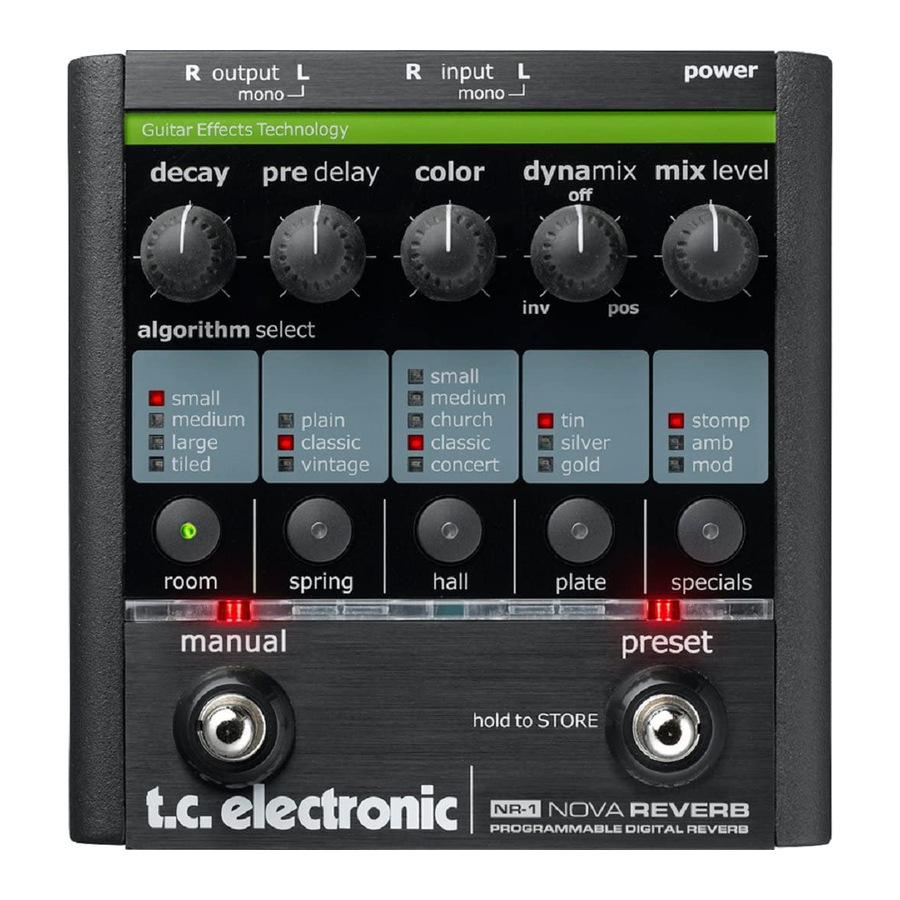
Table of Contents
Advertisement
Advertisement
Table of Contents

Summary of Contents for TC Electronic NR-I Nova Reverb
- Page 1 NR-1 Nova Reverb USER’S MANUAL...
-
Page 2: Table Of Contents
TABLE OF CONTENTS Introduction Table of contents ......2 Introduction ....... .3 Operation Overview . -
Page 3: Introduction
Classic Spring to the pristine and stunningly realistic TC Classic Hall. Reverb just doesn’t come any better than this. TC Electronic, Sindalsvej 34, DK-8240 Risskov – tcdk@tcelectronic.com English Version Manual revision 1.0 – SW – V 1.0 Prod. No: E60506812... -
Page 4: Overview
OVERVIEW output input power mono mono Guitar Effects Technology decay pre delay color dynamix mix level algorithm select small small medium medium church plain stomp large classic classic silver tiled vintage concert gold room spring hall plate specials manual preset hold to STORE NOVA REVERB PROGRAMMABLE DIGITAL REVERB... -
Page 5: Switches
OVERVIEW Connections mode. Manual mode is “What You See Is What You Get”-mode. This means that the Nova Reverb will 1 - Power process exactly according to the current position of the The Nova Reverb require 12V DC 300 mA. Use the controls. -
Page 6: Knobs
OPERATION knobs and LEDs. When storing a preset from preset 8 - Color mode only the edited parameters are stored. The color parameter is used to enhance/emphasize the high-end frequencies of the reverb. Too much high-end Bypass may disturb the source signal. Too little can give you When neither manual nor preset mode LEDs are lit the the impression of a too muddy reverb. -
Page 7: Input Level Calibration
OPERATION Input Level Calibration Reverb Types Your Nova Reverb pedal is per default set up to work Reverb type and sub-type can be selected using well right out the box - just as any other stompbox buttons 11-15. pedal. However, you can optimize the performance of •... - Page 8 OPERATION 13 - Hall 12 - Spring Press Hall to select between the following types of hall Press SPRING to select between the following types of reverb: Small, Medium, Church, Classic and Concert. spring reverb: Plain, Classic and Vintage. Small & Medium Plain Spring Two types of reverb tuned to reproduce the reflection This reverb type is the least colored spring emulation...
- Page 9 OPERATION the original and natural characteristics of the source amount of exquisite and gentle coloring with crystalline material. If you’re looking for a sound with long decay brightness and subtle diffusion. Use this reverb for just times the Concert Hall is excellent and you’ll get a about anything, and especially when you want to add large and broad sound that is very distinctive.
-
Page 10: Reverb Spill-Over
OPERATION Ambience Reverb Spill-over With focus on the early reflections that defines the Smooth transitions when switching from “on” to bypass perception of a room size, the Ambience Reverb type is mode is best achieved by letting the reverb spill over. typically used on dry recordings simply to emulate a This feature can be applied individually for manual or feeling of environment. -
Page 11: Mono/Stereo
SETUP EXAMPLE - MONO/STEREO This setup illustrates how to use the Nova MONO / STEREO Reverb pedal in a mono setup (one amp only) or stereo setup (two amps). A reverb is usually placed as the last effect before amplification Amp INPUT power. -
Page 12: Send/Return
SETUP EXAMPLE - SEND/RETURN This example illustrates how to connect your Nova Reverb pedal as a send/return effect in an effects loop. This is the correct placement of the Nova Reverb if you use the preamp section of the amp for overdrive sounds. Expand this setup to stereo by connecting the Nova pedal right output to the return of a second amp. -
Page 13: Head
SETUP EXAMPLE - HEAD This setup illustrates how to use the Nova pedal in a mono setup using a head and a speaker cabinet. A reverb is usually placed as the last effect before amplification power. Therefore, if you use the drive channel in the output input power... -
Page 14: Technical Specifications
TECHNICAL SPECIFICATIONS Analog Inputs Environment Connectors: ¼” phone jacks w. monosense Operating Temperature: 32° F to 122° F (0° C to 50° C) Input type Single ended Storage Temperature: -22° F to 167° F (-30° C to 70° C) Impedance: 1 MOhm Humidity: Max.














Need help?
Do you have a question about the NR-I Nova Reverb and is the answer not in the manual?
Questions and answers